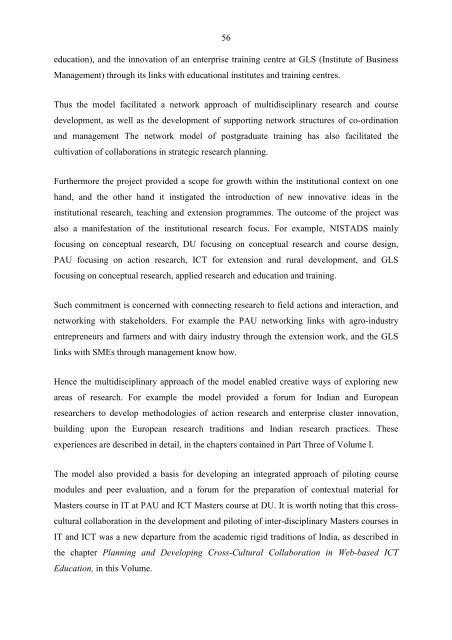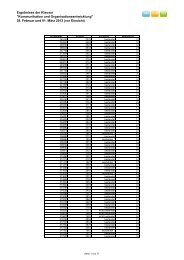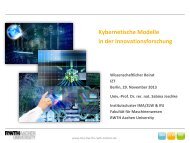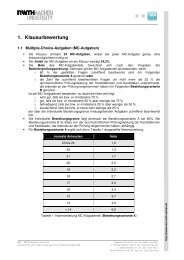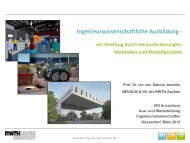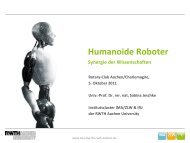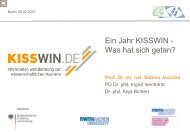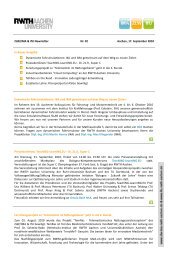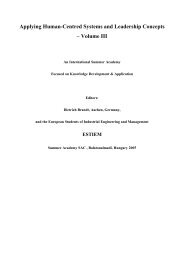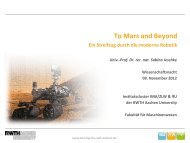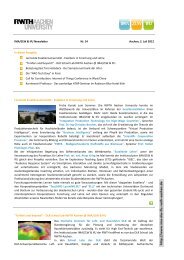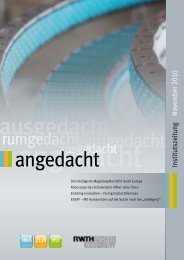Vol. II: Shaping Information and Communication ... - IMA,ZLW & IfU
Vol. II: Shaping Information and Communication ... - IMA,ZLW & IfU
Vol. II: Shaping Information and Communication ... - IMA,ZLW & IfU
Create successful ePaper yourself
Turn your PDF publications into a flip-book with our unique Google optimized e-Paper software.
56<br />
education), <strong>and</strong> the innovation of an enterprise training centre at GLS (Institute of Business<br />
Management) through its links with educational institutes <strong>and</strong> training centres.<br />
Thus the model facilitated a network approach of multidisciplinary research <strong>and</strong> course<br />
development, as well as the development of supporting network structures of co-ordination<br />
<strong>and</strong> management The network model of postgraduate training has also facilitated the<br />
cultivation of collaborations in strategic research planning.<br />
Furthermore the project provided a scope for growth within the institutional context on one<br />
h<strong>and</strong>, <strong>and</strong> the other h<strong>and</strong> it instigated the introduction of new innovative ideas in the<br />
institutional research, teaching <strong>and</strong> extension programmes. The outcome of the project was<br />
also a manifestation of the institutional research focus. For example, NISTADS mainly<br />
focusing on conceptual research, DU focusing on conceptual research <strong>and</strong> course design,<br />
PAU focusing on action research, ICT for extension <strong>and</strong> rural development, <strong>and</strong> GLS<br />
focusing on conceptual research, applied research <strong>and</strong> education <strong>and</strong> training.<br />
Such commitment is concerned with connecting research to field actions <strong>and</strong> interaction, <strong>and</strong><br />
networking with stakeholders. For example the PAU networking links with agro-industry<br />
entrepreneurs <strong>and</strong> farmers <strong>and</strong> with dairy industry through the extension work, <strong>and</strong> the GLS<br />
links with SMEs through management know how.<br />
Hence the multidisciplinary approach of the model enabled creative ways of exploring new<br />
areas of research. For example the model provided a forum for Indian <strong>and</strong> European<br />
researchers to develop methodologies of action research <strong>and</strong> enterprise cluster innovation,<br />
building upon the European research traditions <strong>and</strong> Indian research practices. These<br />
experiences are described in detail, in the chapters contained in Part Three of <strong>Vol</strong>ume I.<br />
The model also provided a basis for developing an integrated approach of piloting course<br />
modules <strong>and</strong> peer evaluation, <strong>and</strong> a forum for the preparation of contextual material for<br />
Masters course in IT at PAU <strong>and</strong> ICT Masters course at DU. It is worth noting that this crosscultural<br />
collaboration in the development <strong>and</strong> piloting of inter-disciplinary Masters courses in<br />
IT <strong>and</strong> ICT was a new departure from the academic rigid traditions of India, as described in<br />
the chapter Planning <strong>and</strong> Developing Cross-Cultural Collaboration in Web-based ICT<br />
Education, in this <strong>Vol</strong>ume.


